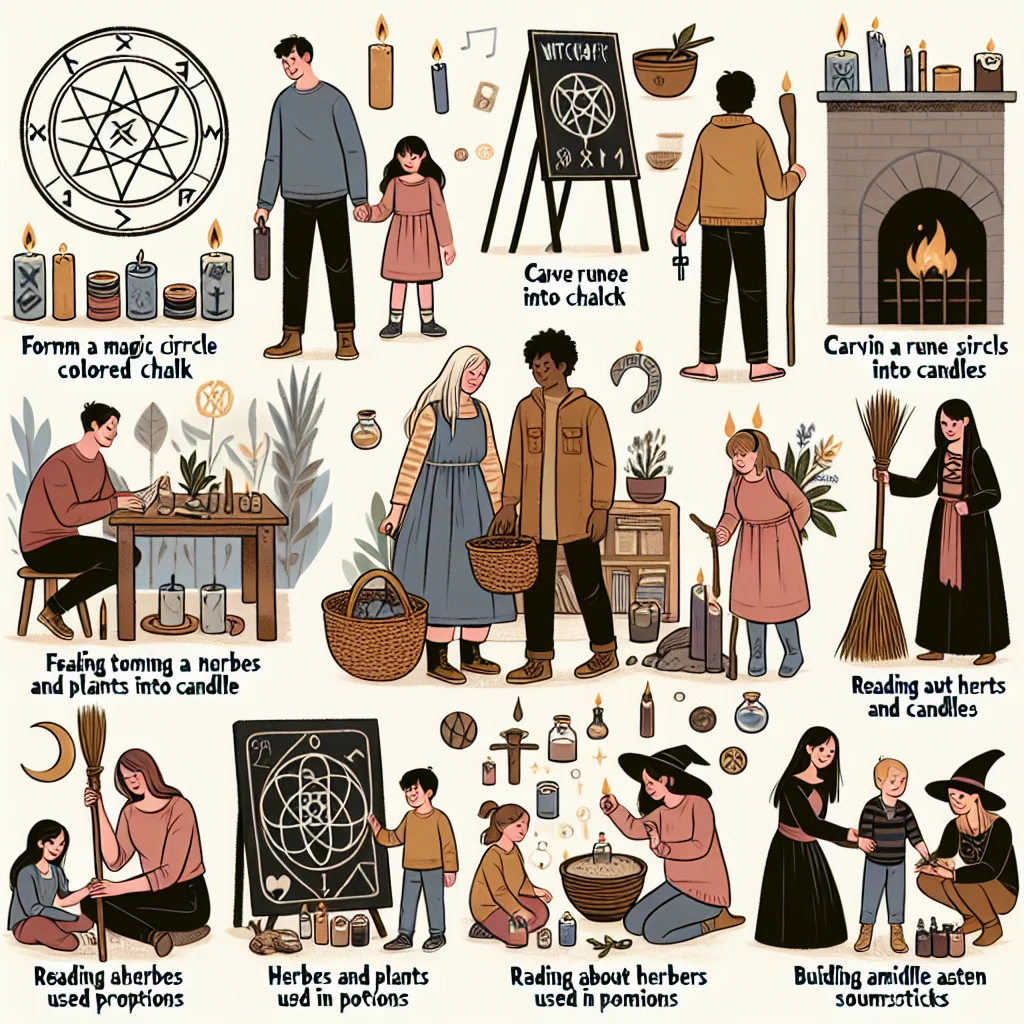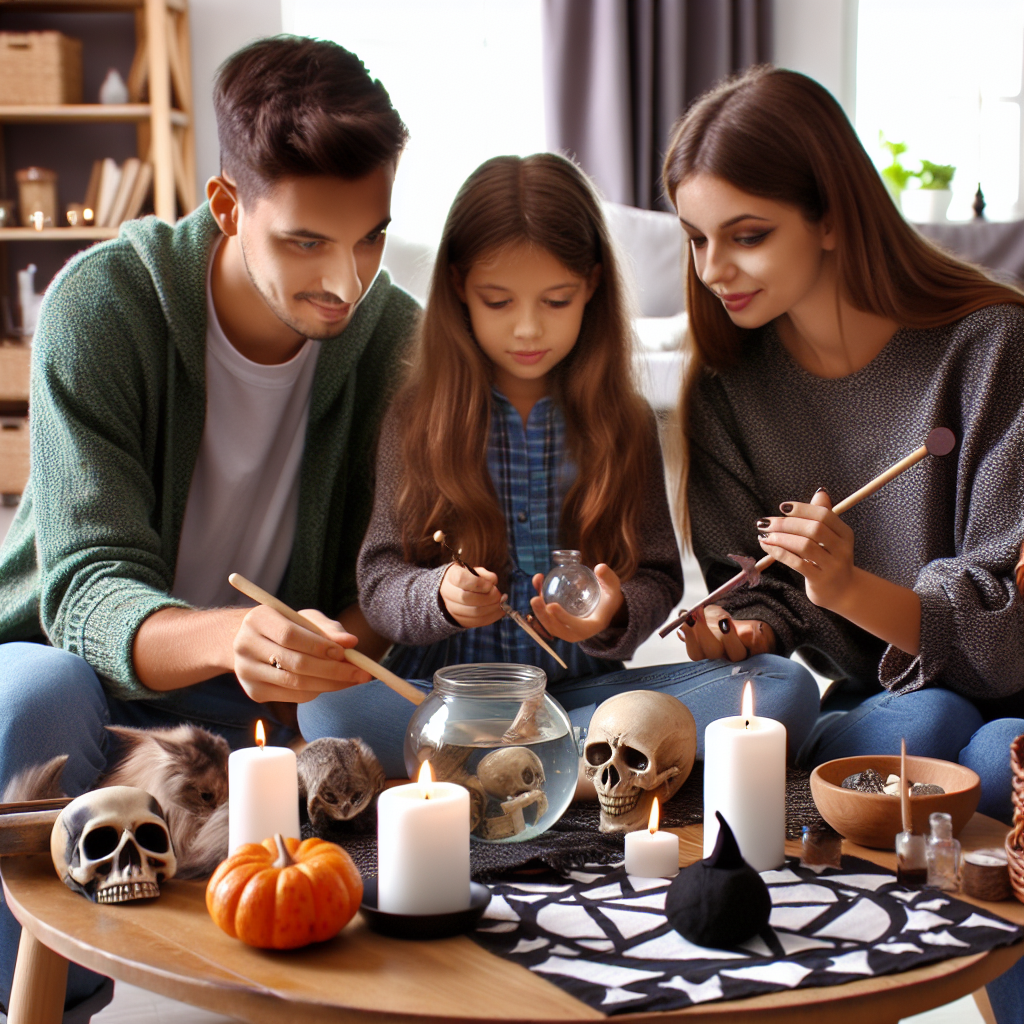As an Amazon Associate I earn from qualifying purchases.

Since ancient times, witchcraft has fascinated and mystified humanity, often intertwining with the natural and supernatural worlds. Today, the practice of witchcraft has seen a resurgence in popularity, with people of all ages seeking to connect with nature, harness personal power, and explore spirituality. While historically misunderstood and sometimes maligned, modern witchcraft is increasingly viewed through a lens of cultural heritage and self-discovery, lending itself to family activities that promote unity and learning.
The roots of witchcraft stretch deep into the past, with evidence of its practice found in various cultures worldwide. It has evolved over centuries, incorporating elements from folklore, herbalism, pagan rituals, and esoteric traditions. This rich tapestry of influences provides a broad spectrum of activities that families can explore together. From creating herbal remedies and learning about the phases of the moon to celebrating seasonal festivals and crafting magical tools, witchcraft offers countless ways to engage with the elements and cycles of nature.
One compelling aspect of family-friendly witchcraft is the opportunity to teach children about the environment and their place within it. For instance, constructing an altar to honor the earth uses elements found in nature and can foster a sense for the importance of ecological stewardship. Such activities can be both grounding and enlightening, underscoring the interdependency between humans and the natural world.
Another interesting facet is the use of storytelling to pass down witchcraft traditions, with 82% of parents believing that storytelling at home helps strengthen family bonds, according to a recent study. Crafting tales together that feature elements of magic and moral lessons can be a creative and unifying activity, enabling families to explore values and traditions in an engaging way.
An activity as simple as going on a nature walk to collect items for a witchy craft can open up conversations about the properties of different plants and how they have been used historically in healing and magical practices. This not only promotes physical activity but also instills appreciation for the biodiversity of the local environment and the wisdom of ancestral knowledge.
Cooking and baking together can also become a witchcraft activity when adding a pinch of intention to recipes. This could mean stirring clockwise to invite positivity or adding spices known for their magical properties, thereby transforming a mundane task into a ritual that involves the whole family.
Finally, exploring the symbolism of animals and their totemic significance has been a part of witchcraft lore for centuries. Families can learn about the various meanings of animals in witchcraft by observing wildlife, studying myths, or using animal cards for insights and reflection. Such activities underscore the relevance of intuition and personal interpretation, which are central to the practice of witchcraft.
Exploring the world of family witchcraft can be an enchanting way for families to spend time together, learn about nature, and tap into their imaginative sides. Here’s a spellbinding selection of witchcraft activities suitable for family members of all ages.
1. **Herb Gardening**: Create a magical garden by planting herbs commonly used in witchcraft, such as lavender, sage, and rosemary. Gardening is a wonderful way to connect with the earth and teach children about the uses of different plants.
2. **Stone Painting**: Paint runes or symbols on stones with your family. You can use these painted stones for decoration, paperweights, or a game of rune casting to practice divination.
3. **Making a Family Grimoire or Book of Shadows**: Collaborate on a handwritten book filled with your family’s favorite spells, rituals, and witchcraft-related recipes.
4. **Candle Making**: Crafting your own candles can be a fun and creative process. Choose colors and scents that align with your intentions, such as green for prosperity or lavender for relaxation.
5. **Kitchen Witchery**: Bake bread, stir up a potion-like soup, or create a magical meal together. Infuse your intention into the cooking process and bless the food before sharing it as a family.
6. **Nature Walks**: Take walks in nature to forage for magical items like feathers, rocks, and plants. Discuss the significance of each item and how it can be used in your craft.
7. **Crafting Spell Jars**: Fill small jars with herbs, stones, and other symbols to create a spell jar. Each family member can make a spell jar for something they wish to manifest.
8. **Moon Observing**: Make it a family event to observe the phases of the moon. Discuss the moon’s influence on the Earth and how different phases can impact spellwork.
9. **Creating Protection Amulets**: Work together to craft amulets out of clay or found objects that each family member can wear or carry for protection.
10. **Sun-Catching**: Make sun-catchers with colored glass or beads that represent different elements or aspects of your family’s practice, and hang them in a sunny window.
11. **Storytelling Evenings**: Share stories of mythology, folklore, and family tales. You can include accounts of witches, faeries, and other magical creatures.
12. **Wand Making**: Go on a hike to find the perfect branches for wand-making. Decorate them with crystals, ribbons, and carvings to personalize your magical tools.
13. **Tea Ceremonies**: Blend your own herbal teas that correspond with your current intentions. Make it a ceremony by setting up a cozy space and focusing on the tea’s properties.
14. **Dream Pillows**: Sew small pillows and stuff them with herbs like mugwort and lavender thought to induce dreams or visions.
15. **Tarot Reading**: Teach and learn tarot card reading as a family. You can do readings for each other or use the cards as a tool for storytelling.
16. **Craft Magical Jewelry**: Create jewelry with natural elements and beads. Each piece can represent an intention, element, or astrological sign.
17. **Elemental Explorations**: Assign each family member an element (earth, air, fire, water) to research and present their findings on how it’s used in witchcraft.
18. **Astrology Night**: Learn about astrology and how the stars can influence magical work. Discuss each family member’s sun, moon, and rising signs.
19. **Seasonal Rituals**: Celebrate the changing seasons with rituals that mark the solstices and equinoxes, as well as the midway points, known as cross-quarter days.
20. **Visualization and Meditation**: Practice guided meditation and visualization exercises to strengthen your family’s mental and spiritual connections.
Engagement in family witchcraft can lead not only to fun and educational experiences but also to a deeper understanding of ourselves and the natural world. A 2018 study published in the American Educational Research Journal showed that family engagement in learning activities like those listed above could enhance children’s literacy and social-emotional skills, highlighting the potential diverse benefits of incorporating such practices within family life.
1. What are some safe witchcraft activities that I can do with young children?
Safe witchcraft activities for young children include herb gardening, making natural crafts, storytelling, and learning about moon phases. It’s important to choose activities that align with nature and creativity, avoiding complex rituals or anything that could be misunderstood.
2. Can practicing witchcraft as a family be educational?
Yes, practicing witchcraft as a family can be very educational. It can teach children about herbalism, the history of witchcraft, nature’s cycles, and cultural traditions. By engaging in these activities, you also promote critical thinking and creativity.
3. Will we need any special materials to start with witchcraft activities?
Many witchcraft activities require minimal and easily accessible materials, such as candles, herbs, stones, paper, and natural items from your environment. Most activities can be adapted to use items you already have at home.
4. How can we ensure that our witchcraft practices are respectful of other cultures?
Research and education are key. Understand the origins and meanings of the traditions you’re incorporating, give credit to those cultures, and avoid appropriating closed practices. Respect for all cultures and their beliefs is paramount in responsible witchcraft practice.
5. Are there any ethical concerns we should be aware of when practicing witchcraft as a family?
When practicing witchcraft, it’s important to consider the “harm none” principle, which means ensuring that your activities do not negatively affect others or the environment. Focus on positive, constructive, and self-improvement aspects of witchcraft.
6. How can we create a ritual space in our home for witchcraft activities?
Creating a ritual space can be as simple as dedicating a small area where you can place items that are significant to your practice, like candles, crystals, and symbols. Keep this space clean and treat it with respect to create a positive environment for your activities.
7. Is it necessary to follow a certain religion to engage in witchcraft activities?
No, it is not necessary to follow a particular religion to engage in witchcraft activities. Witchcraft is a practice that can be incorporated into various religious frameworks or practiced as a standalone spiritual path.
8. What if a family member is skeptical about witchcraft?
Respect their beliefs and skepticism. Share information and experiences about the cultural and historical aspects of witchcraft and emphasize the nature-related, creative, and bonding elements of the activities rather than the spiritual or mystical if that resonates better with them.
9. How can witchcraft activities help with personal development or family bonding?
Witchcraft activities often revolve around self-reflection, intention setting, and appreciation of nature, which can promote personal growth. As a family, these activities can help in creating shared experiences, fostering communication, and building a deeper understanding of each other’s beliefs and values.
10. Can we customize witchcraft activities to fit our family’s unique interests?
Absolutely. Witchcraft is highly individualistic, and you’re encouraged to tailor activities to fit your family’s interests and values. Creativity is at the heart of witchcraft, so feel free to adapt rituals and crafts to what resonates with you and your family.
Conclusion
Exploring witchcraft as a family strengthens bonds and cultivates a shared sense of wonder and creativity. Through the 20 thoughtfully curated witchcraft activities presented, families have been invited to engage in practices that range from crafting protective amulets, concocting herbal potions, to celebrating the cycles of nature with seasonal rituals. Each activity is designed to honor the diversity of witchcraft traditions while being accessible and enjoyable for participants of all ages. Embarking on these activities together not only enhances knowledge about various magical practices but also fosters a deeper connection to the natural world and the diverse energies it holds.
Moreover, these witchcraft activities serve as a gateway for valuable life lessons such as respect for the environment, the importance of intentionality in our actions, and the power of visualization and positive thinking. By incorporating elements of history, folklore, and self-reflection, they encourage personal growth and collective learning. The key insights from these activities are clear: witchcraft can be a playful and profound path for family growth, learning, and joy. As families continue practicing these crafts, they may find themselves developing their own unique traditions and rituals, thus perpetuating a rich cultural heritage and a love for the mystical that can be passed down through generations.
Amazon and the Amazon logo are trademarks of Amazon.com, Inc, or its affiliates.


